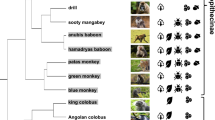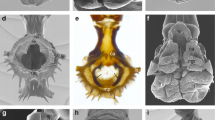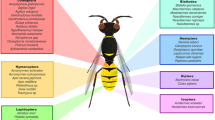Abstract
Insect odorant-binding proteins (OBPs) are thought to play a crucial role in the chemosensation of hydrophobic molecules such as pheromones and host chemicals. The onion fly, Delia antiqua, is a specialist feeder of Allium plants, and utilizes a host odorant n-dipropyl disulfide as a cue for its oviposition. Because n-dipropyl disulfide is a highly hydrophobic compound, some OBPs might be indispensable for perception of it. However, no OBP gene has been identified in D. antiqua. Here, to obtain the DNA sequences of D. antiqua OBPs, we performed an analysis of antennal expressed sequence tags (ESTs). Among 288 EST clones, eight D. antiqua OBP genes were identified for the first time. Phylogenetic analysis revealed that each D. antiqua OBP gene is more closely related to its Drosophila orthologs than to the other D. antiqua OBP genes, suggesting that these OBP genes had emerged before the divergence of Delia and Drosophila species. All of the eight D. antiqua OBPs are expressed not only in the antennae but also in the legs, suggesting additional roles in the taste perception of non-volatile compounds. These findings serve as an important basis for understanding the molecular mechanisms underlying the host adaptations of D. antiqua.


Similar content being viewed by others
References
Pelosi P, Zhou JJ, Ban LP, Calvello M (2006) Soluble proteins in insect chemical communication. Cell Mol Life Sci 63:1658–1676. doi:10.1007/s00018-005-5607-0
Xu PX, Atkinson R, Jones DNM, Smith DP (2005) Drosophila OBP LUSH is required for activity of pheromone-sensitive neurons. Neuron 45:193–200. doi:10.1016/j.neuron.2004.12.031
Laughlin JD, Ha TS, Jones DNM, Smith DP (2008) Activation of pheromone-sensitive neurons is mediated by conformational activation of pheromone-binding protein. Cell 133:1255–1265. doi:10.1016/j.cell.2008.04.046
Matsuo T, Sugaya S, Yasukawa J, Aigaki T, Fuyama Y (2007) Odorant-binding proteins OBP57d and OBP57e affect taste perception and host-plant preference in Drosophila sechellia. Plos Biol 5:985–996. doi:10.1371/journal.pbio.0050118
Harada E, Haba D, Aigaki T, Matsuo T (2008) Behavioral analyses of mutants for two odorant-binding protein genes, Obp57d and Obp57e, in Drosophila melanogaster. Genes Genetic Syst 83:257–264. doi:10.1266/ggs.83.257
Gouinguene SP, Stadler E (2006) Oviposition in Delia platura (Diptera, Anthomyiidae): the role of volatile and contact cues of bean. J Chem Ecol 32:1399–1413. doi:10.1007/s10886-006-9058-3
Ishikawa Y, Ikeshoji T, Matsumoto Y (1978) A propylthio moiety essential to oviposition attractant and stimulant of onion fly, Heylemya antiqua MEIGEN. Appl Entomol Zool 13:115–122
Robertson HM, Martos R, Sears CR, Todres EZ, Walden KKO, Nardi JB (1999) Diversity of odourant binding proteins revealed by an expressed sequence tag project on male Manduca sexta moth antennae. Insect Mol Biol 8:501–518. doi:10.1046/j.1365-2583.1999.00146.x
Jordan MD, Stanley D, Marshall SDG, Silva DD, Crowhurst RN, Gleave AP, Greenwood DR, Newcomb RD (2008) Expressed sequence tags and proteomics of antennae from the tortricid moth, Epiphyas postvittana. Insect Mol Biol 17:361–373. doi:10.1111/j.1365-2583.2008.00812.x
Gonzalez D, Zhao Q, McMahan C, Velasquez D, Haskins WE, Sponsel V, Cassill A, Renthal R (2009) The major antennal chemosensory protein of red imported fire ant workers. Insect Mol Biol 18:395–404. doi:10.1111/j.1365-2583.2009.00883.x
Ishikawa Y, Mochizuki A, Ikeshoji T, Matsumoto Y (1983) Mass-rearing of the onion and seed-corn flies, Hylemya antiqua and Hylemya platura (Diptera, Anthomyiidae), on an artificial diet with antibiotics. Appl Entomol Zool 18:62–69
Hekmat-Scafe DS, Scafe CR, McKinney AJ, Tanouye MA (2002) Genome-wide analysis of the odorant-binding protein gene family in Drosophila melanogaster. Genome Res 12:1357–1369. doi:10.1101/gr.239402
Bendtsen JD, Nielsen H, von Heijne G, Brunak S (2004) Improved prediction of signal peptides: SignalP 3.0. J Mol Biol 340:783–795. doi:10.1016/j.jmb.2004.05.028
Ronquist F, Huelsenbeck JP (2003) MrBayes 3: Bayesian phylogenetic inference under mixed models. Bioinformatics 19:1572–1574. doi:10.1093/bioinformatics/btg180
Letunic I, Bork P (2007) Interactive Tree Of Life (iTOL): an online tool for phylogenetic tree display and annotation. Bioinformatics 23:127–128. doi:10.1093/bioinformatics/btl529
Galindo K, Smith DP (2001) A large family of divergent Drosophila odorant-binding proteins expressed in gustatory and olfactory sensilla. Genetics 159:1059–1072
Honda I, Ishikawa Y (1987) Electrophysiological studies on the dorsal and anterior organs of the onion fly larva, Hylemya antiqua MEIGEN (Diptera, Anthomyiidae). Appl Entomol Zool 22:410–416
Graham LA, Davies PL (2002) The odorant-binding proteins of Drosophila melanogaster: annotation and characterization of a divergent gene family. Gene 292:43–55. doi:10.1186/gb-2007-8-11-r235
Vieira FG, Sanchez-Gracia A, Rozas J (2007) Comparative genomic analysis of the odorant-binding protein family in 12 Drosophila genomes: purifying selection and birth-and-death evolution. Genome Biol 8:R235. doi:10.1186/gb-2007-8-11-r235
Leal WS, Chen AM, Ishida Y, Chiang VP, Erickson ML, Morgan TI, Tsuruda JM (2005) Kinetics and molecular properties of pheromone binding and release. Proc Natl Acad Sci USA 102:5386–5391. doi:10.1073/pnas.0501447102
Author information
Authors and Affiliations
Corresponding author
Electronic supplementary material
Below is the link to the electronic supplementary material.
Rights and permissions
About this article
Cite this article
Mitaka, H., Matsuo, T., Miura, N. et al. Identification of odorant-binding protein genes from antennal expressed sequence tags of the onion fly, Delia antiqua . Mol Biol Rep 38, 1787–1792 (2011). https://doi.org/10.1007/s11033-010-0293-x
Received:
Accepted:
Published:
Issue Date:
DOI: https://doi.org/10.1007/s11033-010-0293-x




